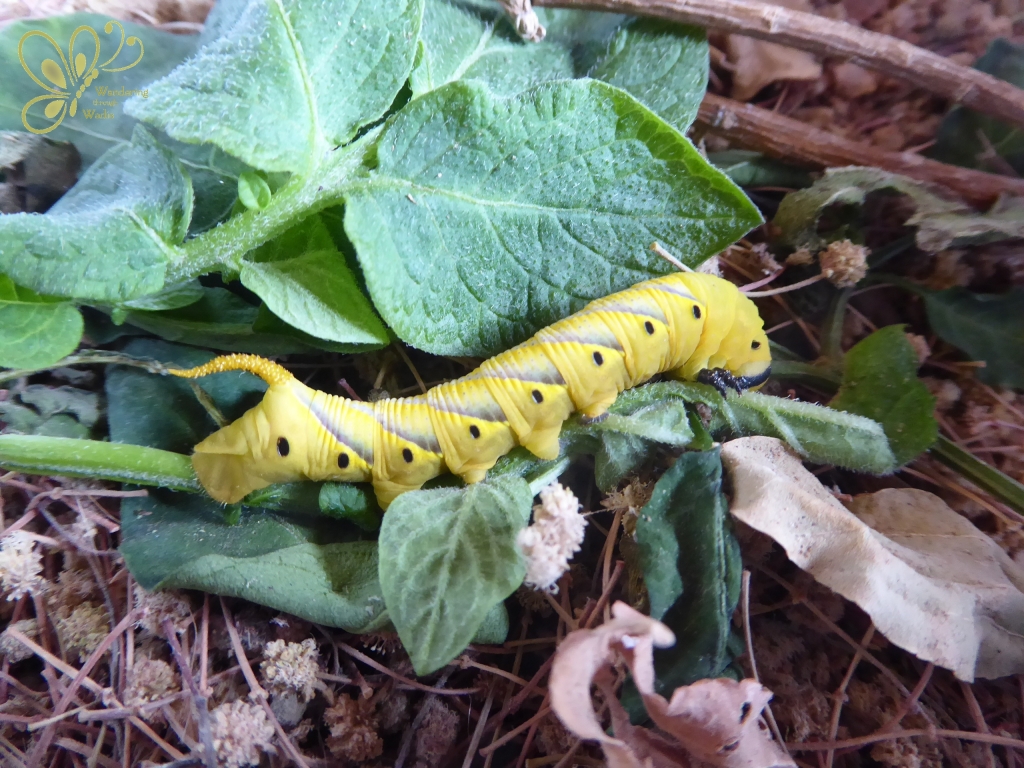
These beautiful wings above belong to a hawkmoth – specifically, to an Eastern Death’s Head Hawkmoth (Acherontia styx). Hawkmoths (family Sphingidae) are known for their sustained and agile flying abilities, reminiscent of a hummingbird’s flight and giving rise to another common name, hummingbird moths. There are 12 species of hawkmoths in Egypt. (You can read about two others on the blog – the Convolvulus Hawkmoth and the Striped Hawkmoth). Like all hawkmoths, the Eastern Death’s Head Hawkmoth has narrow wings and a streamlined abdomen, aiding their fast flying.

Acherontia styx is also known as the Small or Lesser Death’s Head Hawkmoth. Globally, there are three species of Death’s Head Hawkmoths (Acherontia spp.), all named in reference to Greek myths of death. A. styx is named after one of the rivers that divides Earth from the underworld. The moths were given this name in reference to the skull-like markings, with two black spots for eyes, on the back of the thoraxes, in addition to their somewhat-gloomy coloring.

Adults have brown heads, dark thoraxes, and a yellow-striped abdomen. Their forewings are mottled brown, grey, and a reddish color. The hind wings are yellow with two black bands. Eastern Death’s Head Hawkmoths have a wingspan of 80 – 120 mm.

Eggs are laid, and the larvae (caterpillars) feed, on a range of plants – potato, aubergine, tomato, tobacco, olive, as well as Capsicum, Solanum, Datura, and Nicotiana species. The larvae are yellow/green with yellow lateral stripes and go through several instars. When mature, they dig under the soil to pupate.

And these critters get more interesting!
Death’s Head Hawkmoths can, if disturbed, rapidly expel air to emit a loud squeak, similar to that of an agitated mouse. And these hawkmoths are also known as bee moths because of their ability to safely enter bee hives and drink the honey. They do this with the use of a chemical camouflage; they mimic the scent of bees.

Another fun fact: A. styx was featured in the film The Silence of the Lambs. (A victim was found with a pupa of this moth in her windpipe and there is a scene with entomologists determining the species.)

Interestingly, Acherontia styx was, in a study published in 2022, a new record in Egypt. The previous study on Sphingidae moths in Egypt was completed in 2005.
References:
Abdelfattah Mabrouk Amer Salem. Lepidoptera of Egypt Part III: Revision of Family Sphingidae (Bombycoidea). American Journal of Entomology. Vol. 6, No. 1, 2022, pp. 7-13. doi: 10.11648/j.aje.20220601.12

Pingback: Oleander Hawkmoth – Wandering through Wadis